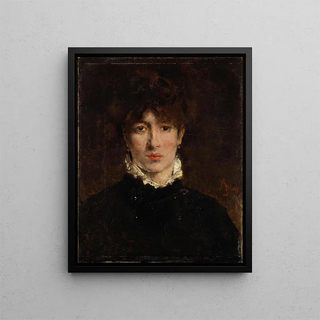Art print | A portrait of a woman believed to be Sarah Bernhardt - Alfred Stevens


View from behind

Frame (optional)
In the vibrant universe of 19th-century art, certain works stand out for their ability to capture the very essence of an era. Among them, the art print Un portrait d'une femme que l'on pense être Sarah Bernhardt, created by Alfred Stevens, serves as an open window into the fascinating world of theater and feminine beauty. This iconic piece evokes not only a mythical figure of French theater but also a refined aesthetic characteristic of the artist. Gazing at this portrait, the viewer is transported into a universe where emotions blend with the delicacy of features, revealing a psychological depth that transcends mere visual representation.
Style and uniqueness of the work
Alfred Stevens' style is characterized by meticulous attention to detail and a delicate color palette. In this portrait, light plays a fundamental role, illuminating the woman's face with an almost supernatural softness. The subtle nuances of the skin, enhanced by delicate shadows, give the figure an almost lifelike dimension. The composition, meanwhile, demonstrates exceptional mastery of the classical portrait, while incorporating elements of modernity that reflect the artistic evolutions of his time. The woman's gaze, both thoughtful and captivating, invites the viewer to ponder her thoughts and emotions, thus creating an intimate connection between the work and its admirer. This singularity, a blend of technical virtuosity and psychological depth, makes this art print a centerpiece of 19th-century art.
The artist and his influence
Alfred Stevens, born in 1823 in Brussels, is a central figure in the artistic movement that developed during the 19th century. Influenced by the great masters of the past, he established himself through his unique style, combining realism and idealization. His work often focuses on themes related to femininity, beauty, and the theatrical scene—subjects that allow him to explore the complexity of human emotions. Stevens was also a pioneer in the use of light and color, inspiring many contemporary artists. His ability to capture the essence

Matte finish

View from behind

Frame (optional)
In the vibrant universe of 19th-century art, certain works stand out for their ability to capture the very essence of an era. Among them, the art print Un portrait d'une femme que l'on pense être Sarah Bernhardt, created by Alfred Stevens, serves as an open window into the fascinating world of theater and feminine beauty. This iconic piece evokes not only a mythical figure of French theater but also a refined aesthetic characteristic of the artist. Gazing at this portrait, the viewer is transported into a universe where emotions blend with the delicacy of features, revealing a psychological depth that transcends mere visual representation.
Style and uniqueness of the work
Alfred Stevens' style is characterized by meticulous attention to detail and a delicate color palette. In this portrait, light plays a fundamental role, illuminating the woman's face with an almost supernatural softness. The subtle nuances of the skin, enhanced by delicate shadows, give the figure an almost lifelike dimension. The composition, meanwhile, demonstrates exceptional mastery of the classical portrait, while incorporating elements of modernity that reflect the artistic evolutions of his time. The woman's gaze, both thoughtful and captivating, invites the viewer to ponder her thoughts and emotions, thus creating an intimate connection between the work and its admirer. This singularity, a blend of technical virtuosity and psychological depth, makes this art print a centerpiece of 19th-century art.
The artist and his influence
Alfred Stevens, born in 1823 in Brussels, is a central figure in the artistic movement that developed during the 19th century. Influenced by the great masters of the past, he established himself through his unique style, combining realism and idealization. His work often focuses on themes related to femininity, beauty, and the theatrical scene—subjects that allow him to explore the complexity of human emotions. Stevens was also a pioneer in the use of light and color, inspiring many contemporary artists. His ability to capture the essence






